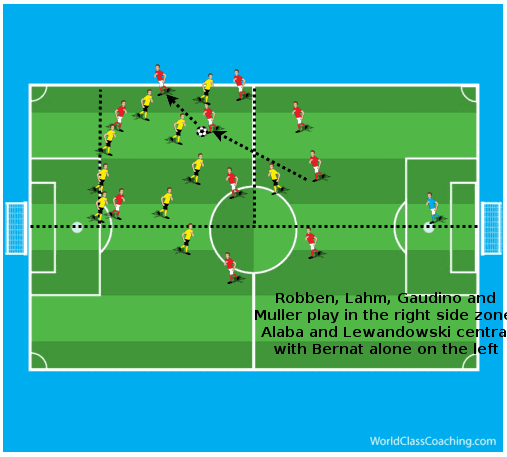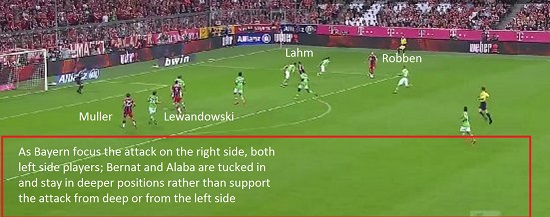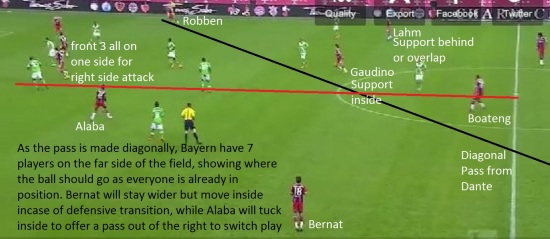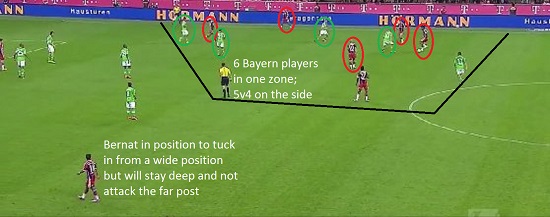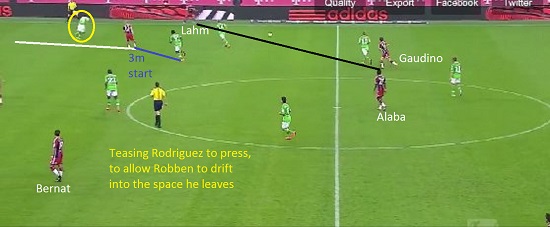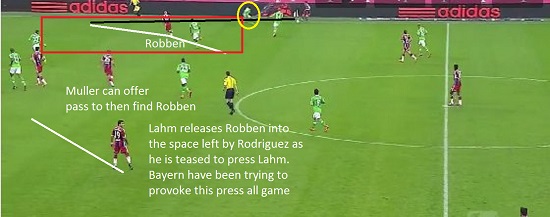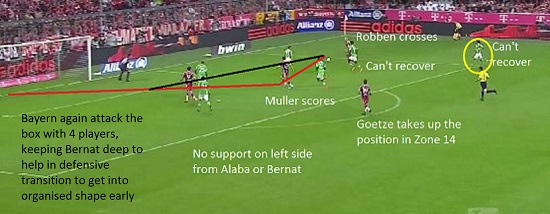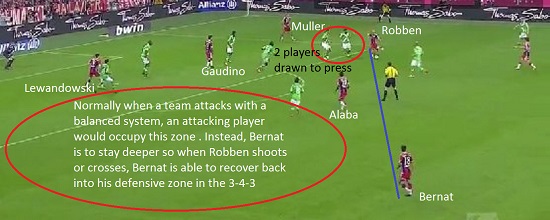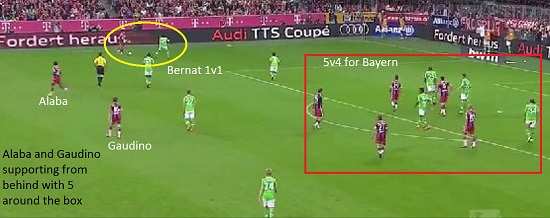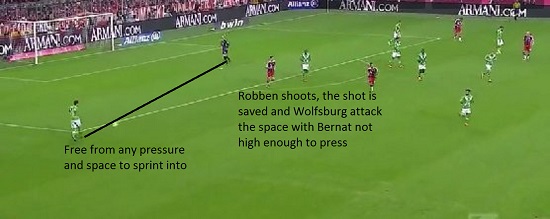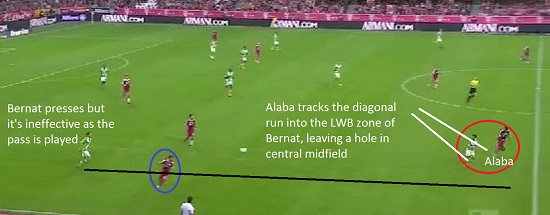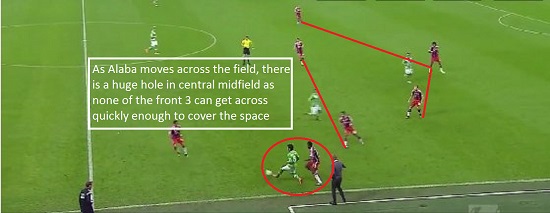By Stevie Grieve
Bayern Munich opened the new Bundesliga season as Champions but without a fully fit squad and missing several key central midfielders, including Toni Kroos who was sold to Real Madrid. In central midfield, they had unknown teenager Gianluca Gaudino and David Alaba, not an ideal pairing on paper if you don’t realise that David Alaba is one of the best footballers in the world in several positions.
In attack, they had a potent from 3 in Robben, Mueller and new signing Robert Lewandowski, players who will always create and score chances.
The game plan for Bayern Munich was to nullify the threat of Kevin de Bruyne and Ricardo Rodriguez down the left side by limiting their space in transition, while pinning them back while Bayern were in possession by dominating the zone with a flood of players and a constant attacking presence.
Bayern set up – Flood the right side and look for 4v3 on the side
As we can see, Bayern would have 4 players wide on the right side, which enables them to move the ball around the area and provoke pressure, allowing Bayern to look for 1-2s or allow runs into spaces, particularly if Rodriguez presses out of the defensive line at left back.
Bayern would normally only commit 4 players to the attack, with Alaba or Lahm in a supporting position deeper than the front 3 and 1 supporting player at the edge of the box. Robben would regularly dribble and cut inside to shoot, while Bernat on the far side would stay deeper instead of leaving space behind him by supporting the attack, which to me looks like transition management as normally the far side wide player would be high to allow circulation and high pressure; something that teams have begun to exploit in Guardiola’s teams in recent history by passing forward quickly to beat the press and exploit the space left.
Robben trademark movement – Cut inside to shoot -4 forward in the last 20m
Here we can see that Bayern have only 4 players in attacking positions v 7 Wolfsburg players, but Robben still cuts inside to shoot with Lewandowski and Muller ready for rebounds.
Positioning for the diagonal switch is set up before the pass
Normally a team would spread open as the ball is brought out, but as the ball is passed across the defence to be switched diagonally to Robben, Bayern don’t re-shape, they stay in the positions to be ready to help Robben as he receives the direct pass across the field, with 7 on one side.
Bayern focus on one zone overload – 5v4 with exit via Alaba
As the ball enters the zone they have been targeting, they ensure that there is an overload, with Alaba in position to receive and exit pass if it is not immediately possible. Bernat stays in a wider position so that Alaba has a passing option. Here, we have 7 players on one side again.
Provoking Pressure to exploit the space left behind the press
One of the ideas that Bayern used a few times was to re-circulate the ball and get Robben central with Lahm high. They would then pass into Lahm who would be pressured by Rodriguez from Left Back, leaving space that Robben could run into behind him. This would either leave Robben free or drag a central player either from midfield or defence with him.
Bayern want Rodriguez to press, and here he does as Lahm is the only player on the side and this is Rodriguez’s responsibility. Robben knows what to do when Rodriguez starts to press Lahm.
Robben creates a goal as Rodriguez can’t recover
As Robben attacks the space, he fakes to cut inside as he always does, instead going outside to cross with Muller and Lewandowski in good positions, which Muller scores from.
Problems with attacking on one side – lack of offensive then transitional defensive balance
Robben cuts inside as he normally does, with 3 inside the box, Alaba supporting with Lahm and Bernat deeper in case of a counter attack. Two players are drawn to press Robben, leaving Muller free and Alaba able to burst into the space.
Bernat isolated on the left with 5 in attacking positions centrally
The unbalance to the attack is clearly visible when we see Bernat playing 1v1 on the side. Although technically good, and very quick, the support he has is unlike a Guardiola team of creating overloads, although in this instance an overload is created in the area Bernat wants to get the ball into.
Problems with attacking one side so heavily – exposure on the weak side
[wpsharely id="2988"][/wpsharely]As the GK catches the ball, instantly Wolfsburg attack the weak side of Bayern.
As Bernat ruses out to press, Alaba has to leave his position at LCM to cover at LWB with his runner.
As Alaba is drawn over and nobody from the attack is able to get over fast enough, Bayern are exposed in central midfield, giving Wolfsburg the ability to pass inside then across to De Bruyne who loves 1v1 play.
By Stevie Grieve. (Follow on Twitter @steviegrieve) Stevie is also the author Coaching the 4-2-3-1 and Coaching the 4-2-3-1 Advanced Tactics

